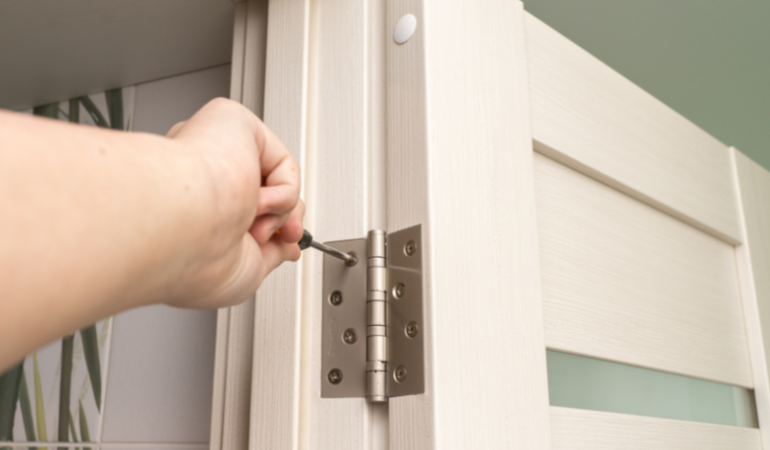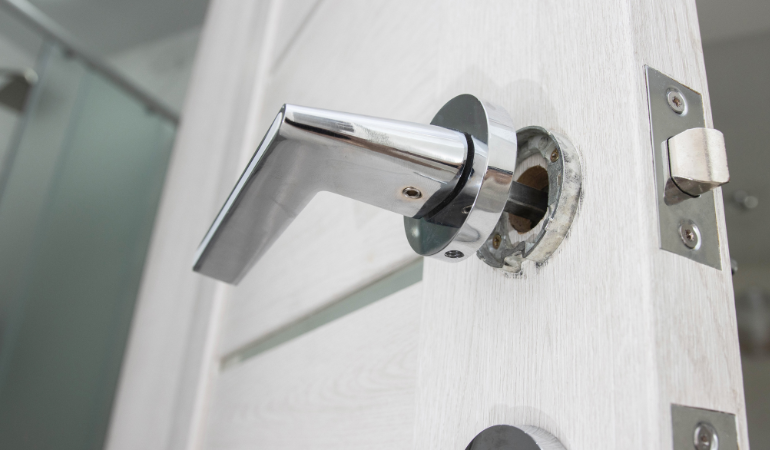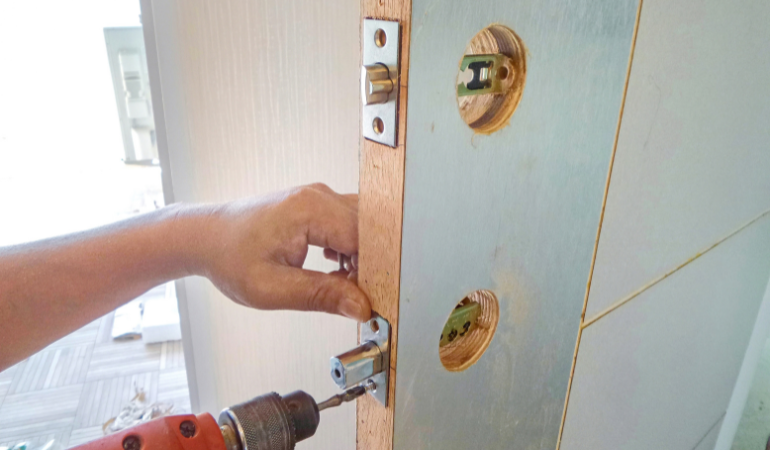Your front door is the entry way to your home and one of the first impressions people have from the kerbside. As with most external fixtures, your external doors are exposed to the elements year round meaning they often need a little TLC to help them stay looking and performing at their best. However, front door refurbishment doesn’t have to be a tough job.
In this guide, we’ve compiled our expert knowledge into helpful tips and advice on how to restore your doors, in a variety of ways. We’ve also included what signs to look out for that it’s time to replace your external doors. So, if you’ve got outdated or underperforming front doors in need of some TLC, you’re in the right place.
Why Restore Your Doors?
Restoring your doors helps you get more years out of your current doors, without the expense of replacing them entirely. Refreshing your doors is more budget friendly than a total replacement, more accessible with simple DIY fixes, and can often achieve effective results that stand up against the elements and leave your doors looking and performing better.
Can You Restore Wooden Doors?
Yes, you can restore wooden doors and it’s easy to carry out plenty of restorations yourself, without a huge budget. So, whatever your problem, there are plenty of solutions to get more from your front door.
Can You Restore Composite Doors?
Absolutely, you can restore composite doors, in fact it’s equally easy to restore composite doors in a variety of ways too. So whether wooden or composite you can restore your front door to help improve its look, feel and performance.
What do you need to fix a door?
The most common door repairs are usually around hinges, locks and handles, with only a handful relating to damage to the actual door. The great thing about this means you’re already likely to have the tools you need to fix a door in your toolbox.
The most common tools you’ll need to fix a door are:
- Spare parts (hinges, handles, locks)
- Screws
- Drill/Drill bits
- Chisel/ Putty knife
- Screwdrivers
- Hammers
- Tape measure
- Wood filler
How to Restore Wooden Doors
There are several ways you can restore wooden front doors, before it’s time to consider a replacement from staining and painting to upgrading your hardware or simply making small repairs to improve performance. We’ve outlined some of the best ways to restore your wooden doors below.
How to Stain Wooden Doors
Staining wooden doors is one of the easiest ways to create an impact, protect your doors from weather related damage and maintain that rustic wooden feel.
- Remove any hardware from the door including handles, numbers and knockers
- Sand the door and dust off any debris with a clean cloth or clean paint brush
- Apply the desired exterior stain carefully, following the direction of the natural woodgrain
- Allow time for this layer to dry, referring to the manufacturer's instructions
- Repeat steps 3 and 4 until the colour has deepened to the desired finish
- Allow the final layer to dry
- If doing both sides, repeat steps 2 to 5 to the internal side of the door
- Re-apply all the hardware removed in step 1
Adding a layer of varnish over stained doors helps seal in the stain and protect this from weathering. The steps below explain how to varnish a door in more detail.
How to Repair Wooden Doors
Wooden doors can take on damage when exposed to wet and cold weather as well as just general wear and tear over the years. Luckily, there are ways to repair wooden doors so damage doesn’t spread.
- Remove any hardware such as handles, knockers or numbers.
- External wooden doors should always have a finish applied, so begin by removing any old stains or treatments by sanding the door down fully
- Wipe the door down to with a cloth or dust it down with a clean, dry paintbrush to remove any dust from sanding and clean the area of any debris
- Using wood filler, either plain or coloured to a tone matching your door, fill any minor cracks, dents, holes or other imperfections. Some fillers can be stained with pigment to achieve a flawless match but always consult the instructions before mixing products.
- Let this filler dry
- Sand all the filler down until flush with the surface of the door
- Complete the restoration with staining or painting following the steps outlined above to ensure a uniform finish for the whole door.
How to Restore Composite Doors
How to Restore Faded Composite Doors
External doors, whether wooden or composite can fade over time from prolonged sun exposure and other weather conditions. However, you can restore the vibrancy of your composite front doors, one of two ways. Assess how faded your doors are to ensure you choose the right restoration methods and materials to avoid disappointment.
To help you restore your faded composite door we’ve outlined two helpful methods below.
Restoring Lightly Faded Doors
- Clean the door thoroughly with a cloth, mild soap and warm water
- Allow to dry thoroughly, it is usually recommended waiting at least 24 hours before applying any products
- Apply a colour restoration solution such as polytrol with a clean cloth or brush. Working in sections starting with the intricate areas first and then moving onto the panels, stiles and horizontal rails
- Allow to dry for a maximum of half an hour before wiping the excess from the surface with a clean, dry cloth
Restoring Heavily Faded Doors
Restoring a heavily faded door may call for a total repaint, which involves more prep and further steps. We recommend reading our guide to painting a front door for in depth instructions, prep advice and more.
How to Repair Composite Doors
For repairing large holes in composite doors:
- Clean the area where the damage has occurred with soap and water, wiping off any excess moisture with a clean, dry cloth. Allow to fully air dry before applying any product
- For more severe damage you may need to carve a V-shape hole surrounding the area to provide an easier, more uniform area to be filled
- Using expanding foam to fill the gap entirely, ensuring there is adequate product in the gap, taking care to not overfill as this will continue to expand as it dries
- Leave to dry for 24h and carefully remove the excess foam with a blade, bringing this as level as possible with the door surface
- Lightly sand any remaining foam until this is completely smooth, uniform and level.
- Use a 2-part plastic filler or autobody filler and go over the top of the area already filled
- For smooth doors, this can be left and painted to match the door. For wood effect doors, a wood grain stamp can be used to mirror the same woodgrain effect and ensure this blends with the rest of the door
- Paint the door with appropriate external paint and seal, if necessary. Refer to your chosen product to determine whether sealant, or other additional steps are needed.
How to Replace a Door Hinge
- Firstly, remove the door from the original hinges. To do this place a screwdriver underneath the hinge's pin and push up to release the pin. Use a hammer to tap the handle of the screwdriver if the pin is stiff.
- Some doors have screws in the middle of the hinge which keeps the pin in place. Open the door to check for these screws and remove if necessary..
- Once the pins have been removed from the hinges, lift the door up and away from the door frame and place it to the side.
- Mark where these hinges sat with chalk or a pencil before removing the screws in both the internal door frame and the internal side of the door.
- Place the new hinges over the previous markings to ensure the exact location of the hinges. Don’t worry if there are discrepancies in where your screws line up as different styles may have different locations. This is just to ensure a stable fit between the door and the frame.
- Attach the hinges to both the door and the frame using either a manual or electric screwdriver.
- Lift and place the new door into position and use the pin to secure the door in place
Top tip: Measure your original hinges to ensure that you select an appropriate replacement. This can be done by holding a piece of paper over the hinges and using a pencil to etch over the top. This will produce a copy of your hinge for you to refer to when shopping. Using a like-for-like hinge fixture will make replacing the hinge easier.

How to fix door handles
Door handles are another area of our doors which are prone to the effects of wear and tear. The repeated motion needed to close and open doors can sometimes cause our door handles to sag or loosen, making them less effective and producing problems with doors opening and closing.
Fixing a door handle
A loose/wobbly door handle:
- Remove the handle from the door by removing each of the screws on the back plate. Depending on the design of your door handle, these screws may be hidden behind the exterior plate which will need to be removed beforehand.
- Once the handle has been removed you should see the interior spindle which runs through the centre of the door. If your handle and the plate are moving, check that this is not the cause of the movement by gently moving this up and down and side to side, checking for any movement that resembles the problem with the handle.
- Next check the screw holes on the door. If these have stretched over time these are likely what’s causing the movement. Using a putty knife, smooth out any raised screw holes as you need a flat surface to work on. Using some wood filler, fill in the screw holes with your putty knife.
- Once the wood filler has cured you can then replace the door handle with freshly drilled holes, preventing movement.

A stiff handle
- Once removed, check the back of the handle plate and check the size of the mechanism (this should be circular and will move as you move the handle). If this is bigger than the hole in the door, this could be why your handle is jamming.
- If this hole is too small, remove the spindle and latch and pull this all out.
- Using a coned drill bit widens this hole to the necessary width, referring to the mechanism on the back for guidance. If you don’t have a coned drill bit, a Stanley knife or other blade will allow you to widen the hole in the same way.
- Once this hole is large enough, replace the door handle as usual ensuring the screws are tight and flush for a perfect fit.
A loose handle
Another reason your door handle might be drooping could be the springs within the handle.
- Once removed, check the springs which appear within the back plate, If these have depleted over time, it’s unlikely that you’ll get replacement ones as the type of springs needed can vary hugely from model to model. At this stage, it is time to replace the door handle.
How to fix a door lock
One of the most common problems with locks is an issue with the deadbolt alignment. The striker plate is fastened to the interior door frame opposite the lock and if the deadbolt and this plate become misaligned you’ll experience problems. To check your deadbolt alignment and rectify this follow these steps:
- Engage your lock so that the deadbolt is out as far as it can go and close the door, so the deadbolt sits against the doorframe. Using a pencil mark the door frame where the deadbolt sits at both the top and bottom.
- Open the door again and disengage the deadbolt. You should now be able to see the striker plate and compare its position against the markings made.
- Depending on the problem (too high, too low, too deep, or too shallow) you’ll need to make adjustments to your striker plate.
- If high/low simply unscrew the plate and reposition accordingly.
- If deep/shallow you will have to mark the outline of the striker board in the door frame and either use wood filler or cut away some of the door to adjust the depth of this striker plate. Using a wood tool like a putty knife can help you apply your filler or shave off the wood to make sure there’s enough space for the plate to sit.
If your lock is not opening anymore and you need to fix your deadbolt lock, follow these steps:
- Remove the handle by carefully unscrewing the screws and lifting the backplate away. Don’t use an electronic screwdriver to remove this as this may damage the lock further.
- Take a look at the mechanism and using a screwdriver, place the tip into the mechanism and try to turn the lock. Often these locks will jam under constant use so the mechanism sometimes just needs realigning slightly.
- Once you have the mechanism moving again and it is functioning as intended, test this a few times. Lock and unlock the door several times before assessing whether to replace the lock or put your handle and backplate back on.
- If you can’t get the mechanism working again, it is time to replace the lock which means moving the entire piece backwards away from the striker plate and pulling this out of the door. At this point, you can then open the door and replace the lock.
- Start off by putting the horizontal fixture into the door which is where the deadbolt is. Then place the back side of the door lock (internal usually) onto the door making sure to place the screws into the appropriate holes.
- Secondly, place the front section of the lock into place (where the key typically goes externally) and tighten the screws from the back.

How to Paint Doors
Painting your front doors is a brilliant choice for those looking to modernise the look and feel of their external door. As an alternative to staining, with paints the options are far more varied so this appeals to people wanting to be bold with their style and completely make over their door, as well as those just refreshing its original colour.
If you want to paint your doors, we recommend reading our comprehensive guide on how to paint front doors; filled with indepth guidance, prep advice and helpful tips.
When to Replace Doors
Sometimes, TLC simply won’t cut it and your old front doors need replacing. While there are several ways to extend the lifespan of your external doors, there will come a time where replacing these makes the most sense. However, it can be hard to establish when your doors are past their best and when to make the investment for new front doors.
We’ve rounded up some of the warning signs you should look for in your external doors that should signal its time for new ones.
Poor Energy Efficiency
Poor energy efficiency can impact the performance of your doors. If you’re noticing an unusual uptick in your energy bills, more draughts, a colder home and you’ve checked your boiler and heating system; it could be your external doors. External doors have changed a lot in recent years with energy efficiency at their core, which means if you’ve got an older door that is showing signs of wear and tear, it might be time to replace this to ensure a cosy home.
Rot, Damp or Cracks
Structural damage such as rot, damp or irreparable cracks to the door itself can massively impact its performance and its safety which can cause issues for front and back doors. Damp and rot are unfortunately very likely to spread to other areas of the door and can be costly and time consuming to repair. If this is the case, it can be easier to identify the reasons for the moisture such as any leaking or damp within the property, address this root cause and replace the door to prevent this issue persisting.
Poor Performance
If your door sticks, has difficulty opening and closing, difficulty locking, or is just generally underperforming in other areas it could be indicative of the need for replacement. It’s important that your front doors serve a primary purpose of securing the property and if they are struggling to do this, then your home is at risk of potential intruders, issues from weather exposure and costly energy bills as you try and maintain a cosy living environment. Replacing your front door, while an investment at the time can help you avoid costly circumstances in the future.
Choosing a Door
Choosing the right front door will depend on a variety of factors from the size of your doorway, to the style of your home and the type of property you live in. At doordeals, we stock a huge variety of external doors from solid to glazed and even bold coloured front doors. So whatever your style or budget we’re here to help pair your home with the perfect front door.
Need some help? Our friendly, expert team is on hand with over a decade of experience and knowledge helping our customers find the right products, at the right prices. Simply get in touch with us to tailored, expert advice for your project.

